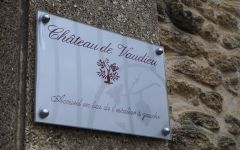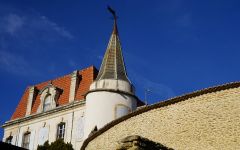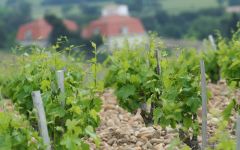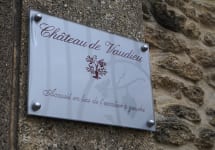Chateau de Vaudieu L'Avenue Chateauneuf-du-Pape 2016
-
Jeb
Dunnuck -
Wine
Enthusiast -
Wine
Spectator -
Robert
Parker



Product Details
Your Rating
Somm Note
Winemaker Notes
In pursuit of more terroir-based cuvées from his 70 hectares of vines, Laurent Brechet created L’Avenue, a Châteauneuf-du-Pape made from 100% Grenache grown primarily on a sandy terroir of decomposed red sandstone. This terroir makes for an expressive and vibrant style of Grenache and one when tasted along side Amiral G, is a masterclass in seeing how terroir in Châteauneuf-du-Pape really matters.
Professional Ratings
-
Jeb Dunnuck
The 2016 Châteauneuf-du-Pape L'Avenue is all Grenache sourced from a single parcel near the estate and aged 18 months in demi-muids. This deeply colored beauty boasts a huge perfume of black raspberries, blackberries, dried flowers, bouquet garni, and sandy/loamy soil notes. With a powerful, concentrated, structured style, incredible purity of fruit, and tons of tannin on the finish, hide bottles for 3-5 years, count yourself lucky, and enjoy over the following decade or more.
Rating: 97+
-
Wine Enthusiast
Baked black cherries and blueberries are shaded by leather, toast and spice in this rich, decadent Grenache. It’s voluminous but not dense, expanding on the palate in creamy swirls. Fine, rigid tannins feel a bit bullish in youth but should meld by 2021. The wine should improve for another decade, likely much longer. Eric Solomon Selections. Cellar Selection
-
Wine Spectator
Intense, with a gorgeous core of crushed plum, boysenberry and blackberry pâte de fruit flavors, inlaid liberally with fruit cake, licorice snap and graphite notes. Fruit pumps through the finish while a graphite edge lends support and a black tea hint checks in. Best from 2020 through 2040.
-
Robert Parker's Wine Advocate
The 2016 Chateauneuf du Pape l'Avenue is entirely Grenache from the lieu-dit Vaudieu, aged in demi-muids. Loaded with black cherries, cedar and vanilla, it's a full-bodied, plush sexpot of a wine. Velvety, intense, long and layered, this wine has it all. If only there were more than 350 cases of this elixir.
Other Vintages
2019-
Jeb
Dunnuck -
Wine
Spectator -
Robert
Parker
-
Jeb
Dunnuck -
Robert
Parker







Located about a five minute drive outside the village of Chateauneuf-du-Pape along the road which leads to Courthezon you will find Chateau de Vaudieu. It is one of three 18th century Chateaux located in the appellation, tucked into a small valley surrounded by hills and plateau. It is at the intersection of several major terroirs: sandy soils to the north, along a border it shares with Chateau Rayas (one of the best wines in Chateauneuf-du-Pape but not actually a Chateau), pale limestone and clays centered around a forested hillock, and two large plateaux of the somewhat overexposed galets. In total there are 70 hectares within one contiguous estate – something very rare in the appellation.

With bold fruit flavors and accents of sweet spice, Grenache, Syrah and Mourvèdre form the base of the classic Rhône Red Blend, while Carignan, Cinsault and Counoise often come in to play. Though they originated from France’s southern Rhône Valley, with some creative interpretation, Rhône blends have also become popular in other countries. Somm Secret—Putting their own local spin on the Rhône Red Blend, those from Priorat often include Merlot and Cabernet Sauvignon. In California, it is not uncommon to see Petite Sirah make an appearance.

Famous for its full-bodied, seductive and spicy reds with flavor and aroma characteristics reminiscent of black cherry, baked raspberry, garrigue, olive tapenade, lavender and baking spice, Châteauneuf-du-Pape is the leading sub-appellation of the southern Rhône River Valley. Large pebbles resembling river rocks, called "galets" in French, dominate most of the terrain. The stones hold heat and reflect it back up to the low-lying gobelet-trained vines. Though the galets are typical, they are not prominent in every vineyard. Chateau Rayas is the most obvious deviation with very sandy soil.
According to law, eighteen grape varieties are allowed in Châteauneuf-du-Pape and most wines are blends of some mix of these. For reds, Grenache is the star player with Mourvedre and Syrah coming typically second. Others used include Cinsault, Counoise and occasionally Muscardin, Vaccarèse, Picquepoul Noir and Terret Noir.
Only about 6-7% of wine from Châteauneuf-du-Pape is white wine. Blends and single-varietal bottlings are typically based on the soft and floral Grenache Blanc but Clairette, Bourboulenc and Roussanne are grown with some significance.
The wine of Chateauneuf-du-Pape takes its name from the relocation of the papal court to Avignon. The lore says that after moving in 1309, Pope Clément V (after whom Chateau Pape-Clément in Pessac-Léognan is named) ordered that vines were planted. But it was actually his successor, John XXII, who established the vineyards. The name however, Chateauneuf-du-Pape, translated as "the pope's new castle," didn’t really stick until the 19th century.
